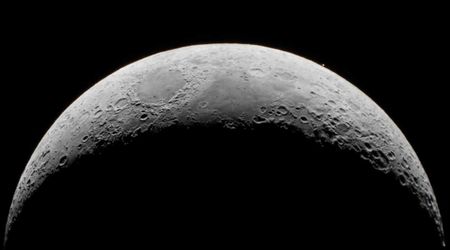Stargazers delight in rare lunar phenomenon revealing giant 'X' and 'V' shapes on the Moon

Observers are encouraged to look skyward on the nights surrounding July 2 for a unique celestial display: the appearance of colossal "X" and "V" formations etched onto the lunar surface — this phenomenon, known as a "clair-obscur" effect, results from specific lighting conditions, as reported on Space.com.

As the moon approaches its first quarter phase, which occurs at 11:41 p.m. EDT on July 2 (0341 GMT on July 3), direct sunlight illuminates the right half of the lunar disk for Northern Hemisphere viewers. This particular angle of illumination creates the illusion of gigantic "V" and "X" markings on the moon's rugged terrain due to the interplay of light and shadow. These distinctive lunar letters are typically visible for approximately four long hours leading up to the first quarter moon. They are most striking when positioned just on the "night" side of the terminator — the dividing line between lunar day and night — with their upper sections catching the Sun's light. Enthusiasts should aim to locate these features at sunset on July 2 and observe their gradual evolution. Even if initially missed, the "X" and "V" remain briefly visible as they transition to the moon's "day side."
The lunar "X" is an optimal effect formed by sunlight striking elevated rim sections of the Bianchini, Purbach, and La Caille Craters. It can be found approximately 25 degrees south of the lunar equator, near the terminator and the prominent Werner and Aliacensis Craters. To spot the lunar "V," observers should trace the terminator line to a point less than 10 degrees above the lunar equator, where the partially shadowed Ukert Crater forms the "V." Both features are discernible with a small backyard telescope, though a larger instrument will offer enhanced detail of the surrounding lunar landscape.

Adding to the celestial wonders, stargazers also have an exceptional chance to observe Mercury, our solar system's innermost planet, in the evening sky until early July. This extended viewing period, which began on June 20 with a notable alignment of the Moon, Mercury, and the Gemini Twins, offers a prime opportunity to spot the often-elusive planet, typically hidden by its proximity to the Sun.

Unlike its usual brief appearances, Mercury's prolonged visibility this month has been a boon for observers. The planet will reach its greatest elongation from the Sun on July 4, allowing it to climb higher above the west-northwest horizon. While previous winter viewings benefited from darker skies, early summer's longer twilight hours mean Mercury will be seen against a brighter backdrop. On June 20, Mercury even surpassed Arcturus, one of the brightest stars in the northern sky, in brightness, shining at a magnitude of -0.2. By July 3, although it will dim slightly to +0.5, it will rank among the ten brightest stars, making it visible approximately 45 minutes to an hour after sunset.

In more news surrounding our Moon, the full Buck Moon is set to illuminate the night sky on Thursday, July 10. As with all full moons, it will consistently rise around sunset and set near sunrise. This predictable behaviour occurs because a full moon is positioned directly opposite the Sun in the sky, allowing it to receive and reflect the Sun's full illumination towards Earth.









